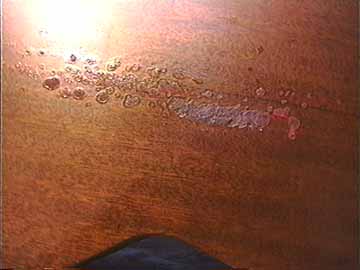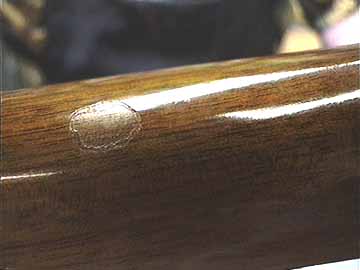Rubber is no kind of friend, but
Vinyl is the Enemy
© Frank Ford, 4/18/98; Photos by FF, 4/17/98
About a hundred years ago, I left my my mandolin lying on the table, on top
of a vinyl bag. I don't know why I left the thing there for a week, but I did.
When I picked up my instrument, the guitar bag underneath was stuck right to
it. Made quite an impression in the finish, and on me as well!
I wish I could say that I hadn't known of the danger vinyl presents to lacquer.
Really, I didn't expect I'd be leaving my instrument there that long, and/or
I had forgotten that the bag was made of vinyl.
So here's the deal: Vinyl eats lacquer.
Well, of course, it's not really that simple, but vinyl does present significant
danger to a nitrocellulose lacquer finish. Rubber also can discolor and soften
lacquer, so some of my comments will apply to rubber as well.
Here's what a vinyl strap did to the back of a Martin 0-16NY:

The strap was laid across the back of the guitar when it was put into its case.
The blisters are areas where the lacquer was softened and made sticky. They're
still sticky years later! If you squint closely toward the right of the
damage, you'll see the red case lining fuzz embedded in the sticky finish.
A vinyl covered guitar stand did this:

Same thing, except that all the finish stuck to the stand.
If you're unlucky enough you'll find that certain capos can inflict this same
bit of damage, as Paige Murphy of Sanford, NC did:
" Last year I finally made my big guitar purchase. I
bought a Gibson J-150. This guitar is a "blonde"-- natural maple
finish. I used a capo with, I guess, a rubber "protector" on the
part that clamps behind the neck. After a few days, I noticed dark spots occuring
on the neck. The first two I thought were imperfections in the wood. Then
later noticed there were more and at regular intervals. Then made the connection:one
to one correspondence with each fret position on the front. I covered my capo
clamp with black cotten material and it hasn't gotten worse, but the spots
are still there."
This vinyl damage can be repaired, but it is a messy process.
First you have to get down to solid material, and that usually means dissolving
the softened finish away. At that point there's often significant color touch-up
necessary in addition to filling and blending a new thickness of lacquer. In
some cases the only good repair is to refinish the entire affected surface.
I find it interesting (and revolting) that you still can buy stands, hangers
and straps made with vinyl. Most, if not all, are sold without disclaimers about
the damage they can cause!
Also, it's an irony that these days it's the expensive instruments that are
at risk.
Speaking of risk, here's how it goes, more or less. The newer the vinyl, the
faster it will cause a reaction in the lacquer. The most sensitive lacquer is
the traditional nitrocellulose lacquer that used to be the standard finish on
all guitars and other fretted instruments.
Modern catalyzed polymer finishes are immune to the vinyl damage.
Martin's standard line of guitars has been finished with nitrocellulose lacquer
since around 1930. The D-1 and its relatives are catalyzed polymer.
Gibson and Guild use nitrocellulose.
Nitrocellulose lacquer is used by most individual luthiers and small factories
such as Santa Cruz and Collings.
Taylor uses a catalyzed finish, although very early Taylors are lacquered.
Virtually all imported steel string guitars, mandolins and banjos are finished
with catalyzed polymer.
If you're in doubt about the sensitivity of your finish, check with the manufacturer
or just avoid vinyl.
Vinyl isn't the only agent that affects finish chemically. Bug spray is notorious
for attacking nitrocellulose lacquer. Certain colognes do it too. . .
Back to Index Page